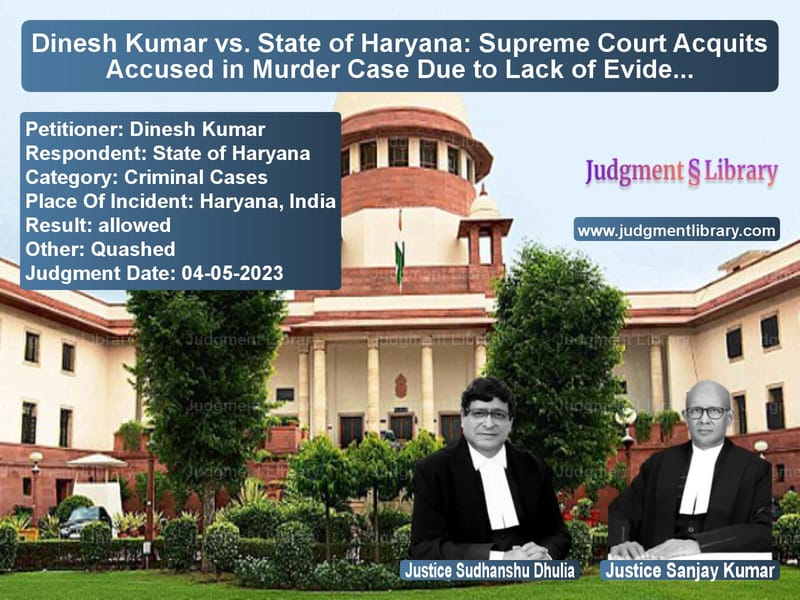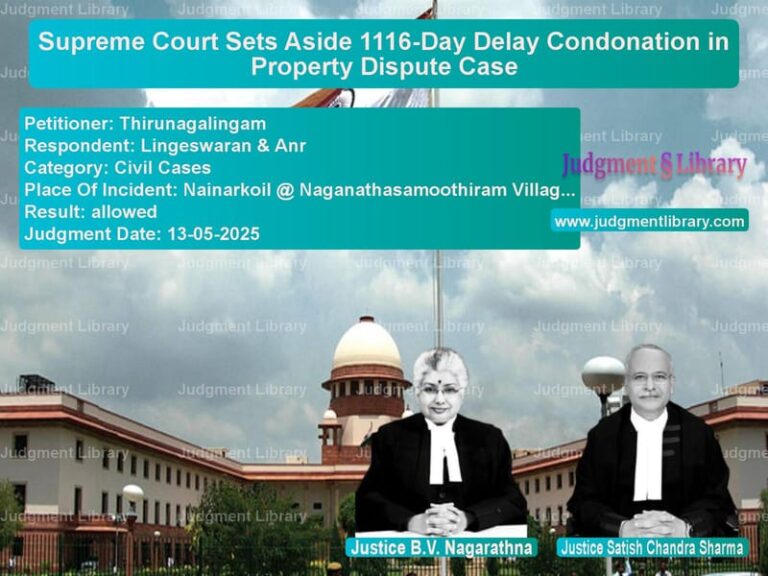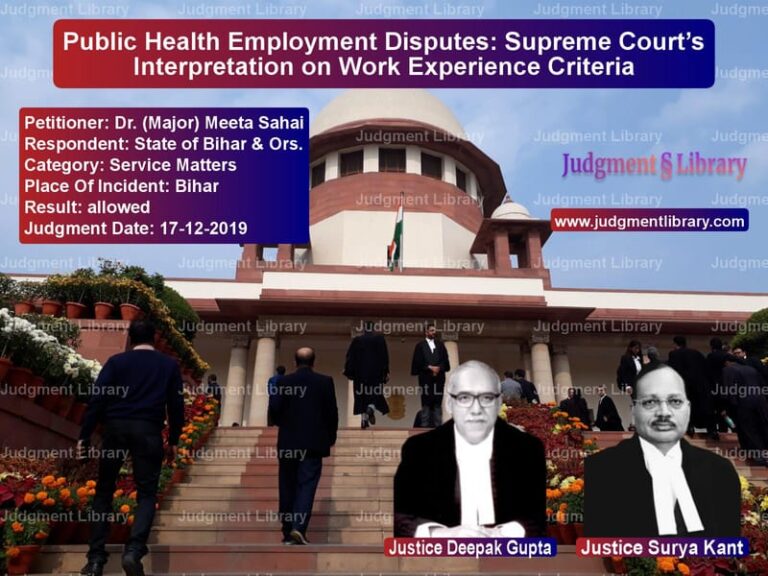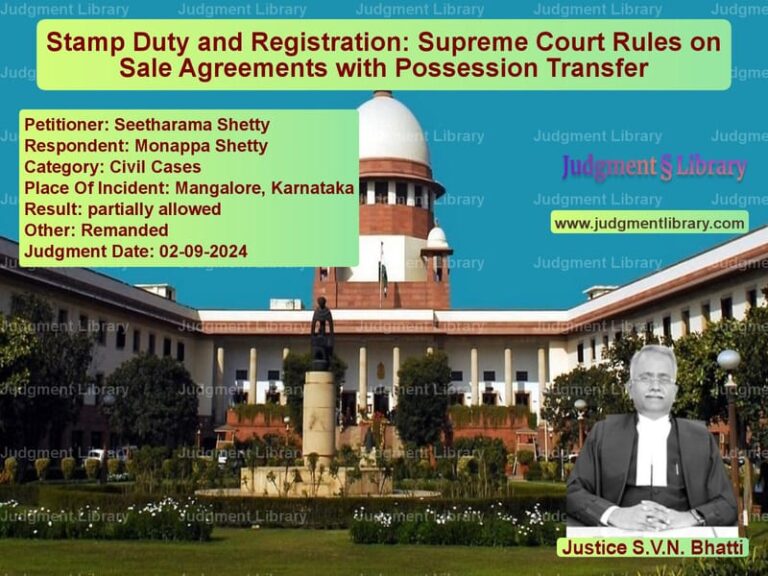Dinesh Kumar vs. State of Haryana: Supreme Court Acquits Accused in Murder Case Due to Lack of Evidence
The case of Dinesh Kumar vs. State of Haryana is a landmark judgment in the domain of criminal law, wherein the Supreme Court examined the prosecution’s reliance on circumstantial evidence and procedural lapses. The appellant was convicted for murder under Sections 302, 364, 392, 394, and 201 of the Indian Penal Code (IPC) and sentenced to life imprisonment. However, the Supreme Court overturned the conviction, emphasizing the prosecution’s failure to establish a complete chain of circumstantial evidence beyond a reasonable doubt.
Background of the Case
The case revolves around the murder of Gurmail Singh, a resident of village Dhimo in Haryana. On the morning of 8th May 2000, he left his village on his tractor to visit his sister and brother-in-law in Dadupur, which was 15-20 kilometers away. He was last seen leaving their house at 5:30 PM on the same day. However, he never returned home.
After three days, on 11th May 2000, his brother, Harbans Singh, went to inquire about his whereabouts. Upon learning that Gurmail had left for home on 8th May, he lodged an FIR at Police Station Buria, District Yamuna Nagar, at 4:00 PM on 11th May. In the FIR, he stated that Gurmail had been seen on his tractor around 7:00 PM on 8th May 2000 in the company of two individuals, Mange Ram and Dinesh Kumar, who were from nearby villages. He further alleged that both individuals were known vagabonds and had kidnapped his brother to rob him of his tractor.
On 12th May 2000, Gurmail Singh’s body was found floating in a canal. An autopsy was conducted on the same day at 4:15 PM, and the cause of death was determined as asphyxia due to strangulation. The prosecution then charged the accused under Sections 302, 364, 392, 394, and 201 IPC.
Prosecution’s Case
The prosecution relied entirely on circumstantial evidence. Their case rested on two main factors:
- Last Seen Evidence: The prosecution presented Karanjit Singh (PW-10), who claimed to have seen the deceased in the company of the accused at 7:00 PM on 8th May 2000.
- Recovery of Articles: The police claimed to have recovered the deceased’s wristwatch, a turban, currency notes of Rs. 250, and burnt hair from the accused’s residence.
Additionally, the prosecution claimed that Mange Ram, the co-accused, had led the police to the location where they had abandoned the deceased’s tractor and dumped the body.
Petitioner’s Arguments
The petitioner’s counsel argued:
- The entire case was based on circumstantial evidence, with no direct proof linking the accused to the murder.
- The prosecution failed to explain why rigor mortis was still present in the body after 90 hours, which was highly unusual.
- The alleged recovery of the deceased’s belongings from the appellant’s house was fabricated, as these items were never conclusively linked to the deceased.
- The appellant’s disclosure statements were inadmissible, as the locations of the tractor and the murder site had already been revealed by the co-accused.
- There was no forensic evidence establishing the accused’s involvement.
Respondents’ Arguments
The State of Haryana countered:
- The last seen evidence was credible and placed the appellant in the company of the deceased shortly before his disappearance.
- The prosecution had proven motive—robbery of the deceased’s tractor.
- The appellant had failed to explain his presence with the deceased, strengthening the inference of guilt under Section 106 of the Indian Evidence Act.
- The recoveries made from the appellant’s house confirmed his involvement.
Supreme Court’s Observations
The Court meticulously analyzed the case and pointed out major inconsistencies:
- The last seen evidence was weak, as there was a significant time gap between when the deceased was last seen and when his body was found.
- There was no direct forensic evidence linking the appellant to the crime.
- The presence of rigor mortis after 90 hours was unusual and raised doubts about the actual time of death.
- The alleged discoveries from the appellant’s house were unreliable as they were not independently verified.
- Since the co-accused had already disclosed the locations of the tractor and body, the appellant’s disclosure was not a fresh discovery under Section 27 of the Indian Evidence Act.
Key Judgment Excerpt
The Supreme Court remarked:
“In our considered view, in the present case the prosecution has not been able to prove its case beyond reasonable doubt. The evidence of last seen, only leads up to a point and no further. It fails to link it further to make a complete chain.”
The Court further emphasized the need for a complete chain of circumstantial evidence and reiterated that Section 106 of the Indian Evidence Act does not shift the burden of proof to the accused unless the prosecution has first established a prima facie case.
Final Verdict
The Supreme Court set aside the conviction and ordered the immediate release of the appellant, concluding that the prosecution had failed to establish the guilt of the accused beyond reasonable doubt.
Petitioner Name: Dinesh Kumar.Respondent Name: State of Haryana.Judgment By: Justice Sudhanshu Dhulia, Justice Sanjay Kumar.Place Of Incident: Haryana, India.Judgment Date: 04-05-2023.
Don’t miss out on the full details! Download the complete judgment in PDF format below and gain valuable insights instantly!
Download Judgment: dinesh-kumar-vs-state-of-haryana-supreme-court-of-india-judgment-dated-04-05-2023.pdf
Directly Download Judgment: Directly download this Judgment
See all petitions in Murder Cases
See all petitions in Fraud and Forgery
See all petitions in Custodial Deaths and Police Misconduct
See all petitions in Judgment by Sudhanshu Dhulia
See all petitions in Judgment by Sanjay Kumar
See all petitions in allowed
See all petitions in Quashed
See all petitions in supreme court of India judgments May 2023
See all petitions in 2023 judgments
See all posts in Criminal Cases Category
See all allowed petitions in Criminal Cases Category
See all Dismissed petitions in Criminal Cases Category
See all partially allowed petitions in Criminal Cases Category







